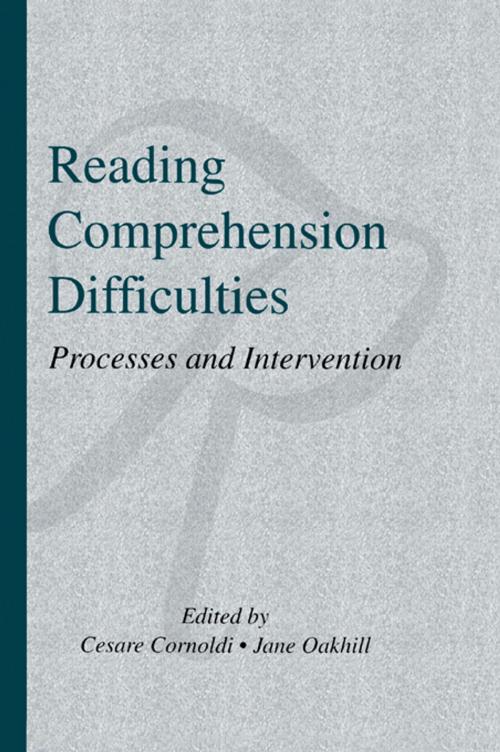Reading Comprehension Difficulties
Processes and Intervention
Nonfiction, Reference & Language, Education & Teaching, Teaching, Teaching Methods, Health & Well Being, Psychology| Author: | ISBN: | 9781136488627 | |
| Publisher: | Taylor and Francis | Publication: | April 3, 2013 |
| Imprint: | Routledge | Language: | English |
| Author: | |
| ISBN: | 9781136488627 |
| Publisher: | Taylor and Francis |
| Publication: | April 3, 2013 |
| Imprint: | Routledge |
| Language: | English |
Recognizing the characteristics of children with learning disabilities and deciding how to help them is a problem faced by schools all over the world. Although some disorders are fairly easily recognizable (e.g., mental retardation) or very specific to single components of performance and quite rare (e.g., developmental dyscalculia), schools must consider much larger populations of children with learning difficulties who cannot always be readily classified. These children present high-level learning difficulties that affect their performance on a variety of school tasks, but the underlying problem is often their difficulty in understanding written text. In many instances, despite good intellectual abilities and a superficial ability to cope with written texts and to use language appropriately, some children do not seem to grasp the most important elements, or cannot find the pieces of information they are looking for. Sometimes these difficulties are not immediately detected by the teacher in the early school years. They may be hidden because the most obvious early indicators of reading progress in the teacher's eyes do not involve comprehension of written texts or because the first texts a child encounters are quite simple and reflect only the difficulty level of the oral messages (sentences, short stories, etc.) with which the child is already familiar. However, as years go by and texts get more complex, comprehension difficulties will become increasingly apparent and increasingly detrimental to effective school learning. In turn, studying, assimilating new information, and many other situations requiring text comprehension -- from problem solving to reasoning with linguistic contents -- could be affected.
Problems with decoding, dyslexia, and language disorders have attracted more interest from researchers than have specific comprehension problems and have occupied more room in specialized journals. Normal reading comprehension has also been a favorite with researchers. However, scarce interest has been paid to subjects who have comprehension difficulties. This book is an attempt to remedy this situation. In so doing, this volume answers the following questions:
* Does a reading comprehension problem exist in schools?
* How important and widespread is the problem?
* Is the problem specific?
* How can a reading comprehension difficulty be defined and identified?
* Does the "syndrome" have a single pattern or can different subtypes be identified?
* What are the main characteristics associated with a reading comprehension difficulty?
* When can other well-identified problems add to our understanding of reading comprehension difficulties?
* Which educational strategies are effective in preventing and treating reading comprehension difficulties?
* What supplementary information can we get from an international perspective?
Recognizing the characteristics of children with learning disabilities and deciding how to help them is a problem faced by schools all over the world. Although some disorders are fairly easily recognizable (e.g., mental retardation) or very specific to single components of performance and quite rare (e.g., developmental dyscalculia), schools must consider much larger populations of children with learning difficulties who cannot always be readily classified. These children present high-level learning difficulties that affect their performance on a variety of school tasks, but the underlying problem is often their difficulty in understanding written text. In many instances, despite good intellectual abilities and a superficial ability to cope with written texts and to use language appropriately, some children do not seem to grasp the most important elements, or cannot find the pieces of information they are looking for. Sometimes these difficulties are not immediately detected by the teacher in the early school years. They may be hidden because the most obvious early indicators of reading progress in the teacher's eyes do not involve comprehension of written texts or because the first texts a child encounters are quite simple and reflect only the difficulty level of the oral messages (sentences, short stories, etc.) with which the child is already familiar. However, as years go by and texts get more complex, comprehension difficulties will become increasingly apparent and increasingly detrimental to effective school learning. In turn, studying, assimilating new information, and many other situations requiring text comprehension -- from problem solving to reasoning with linguistic contents -- could be affected.
Problems with decoding, dyslexia, and language disorders have attracted more interest from researchers than have specific comprehension problems and have occupied more room in specialized journals. Normal reading comprehension has also been a favorite with researchers. However, scarce interest has been paid to subjects who have comprehension difficulties. This book is an attempt to remedy this situation. In so doing, this volume answers the following questions:
* Does a reading comprehension problem exist in schools?
* How important and widespread is the problem?
* Is the problem specific?
* How can a reading comprehension difficulty be defined and identified?
* Does the "syndrome" have a single pattern or can different subtypes be identified?
* What are the main characteristics associated with a reading comprehension difficulty?
* When can other well-identified problems add to our understanding of reading comprehension difficulties?
* Which educational strategies are effective in preventing and treating reading comprehension difficulties?
* What supplementary information can we get from an international perspective?















